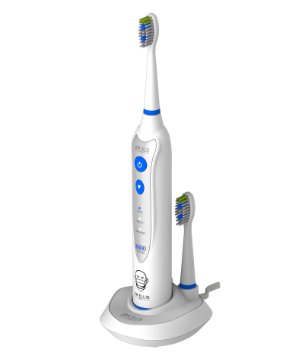
The first electric toothbrush, the Broxodent, was invented in Switzerland in 1954 by Dr. Philippe Guy Woog.[1] Woog's electric toothbrushes were originally manufactured in Switzerland (later in France) for Broxo S.A. The device plugged into a standard wall outlet and ran on line voltage. Electric toothbrushes were initially created for patients with limited motor skills and for orthodontic patients (such as those with braces).[citation needed]
The Broxo Electric Toothbrush was introduced in the USA by E. R. Squibb and Sons Pharmaceuticals in 1959. After introduction, it was marketed in the USA by Squibb under the names Broxo-Dent or Broxodent. In the 1980s Squibb transferred distribution of the Broxodent line to the Somerset Labs division of Bristol Myers/Squibb.[2]
The General Electric Automatic Toothbrush was introduced in the early 1960s; it was cordless with rechargeable NiCad batteries and although portable, was rather bulky, about the size of a two-D-cell flashlight handle.[3] NiCad batteries of this period suffered from the Memory effect. The GE Automatic Toothbrush came with a charging stand which held the hand piece upright; most units were kept in the charger, which is not the best way to get maximum service life from a NiCad battery. Also, early NiCad batteries tended to have a short lifespan. The batteries were sealed inside the GE device, and the whole unit had to be discarded when the batteries failed.
The use of an AC line voltage appliance in a bathroom environment was problematic. By the early 1990s Underwriter Laboratories (UL) and Canadian Standards Association (CSA) no longer certified line-voltage appliances for bathroom use. Newer appliances had to use a step-down transformer to operate the actual toothbrush at low voltage (typically 12, 16 or 24 volts). Wiring standards in many countries require that outlets in bath areas must be protected by a RCD/GFCIdevice (e.g., required in USA since the 1970s on bathroom outlets in new construction).
By the 1990s there were problems with safety certification of Broxo's original design. Further, improved battery-operated toothbrushes were providing formidable competition. Broxo S. A. still produces and markets a low-voltage model, but its public visibility in the USA has been limited in the face of large competitors, such as Philips Sonicare and Braun Oral-B models.[citation needed]
The first ultrasonic toothbrush, first called the Ultima and later the Ultrasonex, was patented in the USA in 1992, the same year the FDA gave it approval for daily home use. Initially, the Ultima worked only on ultrasound, but a few years later, a motor was added to give the Ultrasonex brush additional sonic vibration. Today, several ultrasonic toothbrushes simultaneously provide both ultrasound and sonic vibration. In more modern times, electric toothbrushes have been used as a substitute for vibrators for those that wish to avoid embarrassment.[4]